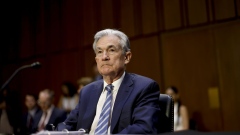Jan 11, 2021
Will Powell and Yellen test MMT in the U.S.?
, Bloomberg News
Biden nominates Janet Yellen as Treasury secretary
Georgia voters might have given the green light to Modern Monetary Theory in America.
Immediately after November’s election, I wrote that the Federal Reserve would have the weight of the world’s largest economy on its shoulders yet again, given what looked to be a divided government. At the time, Republicans were all but guaranteed to retain control of the Senate, dashing hopes of politicians working hand-in-hand with the central bank to provide ample fiscal stimulus to get Americans through the coronavirus pandemic.
Even after President-elect Joe Biden selected former Fed Chair Janet Yellen to serve as the next Treasury secretary later in November, I and others were skeptical that she alone could muster the kind of fiscal support that central bankers had been pleading for throughout much of 2020. More likely, it signaled that Biden didn’t expect much cooperation on his agenda from what polls were still saying would be a Republican-controlled Senate, causing him to lean more heavily on monetary policy to buoy the economy.
Less than two weeks out from Inauguration Day, the outlook is suddenly much different. Democrats won narrow control of the Senate, with Raphael Warnock and Jon Ossoff defeating Republican opponents Kelly Loeffler and David Perdue in Georgia’s runoff elections. Chuck Schumer of New York stands to become majority leader and has already said US$2,000 stimulus checks are one of the first things he wants the new Senate to pass, with aid for state and local governments and unemployed Americans also likely a priority. Democrats can probably do all that alone. Biden said he would lay out details of his stimulus package on Thursday, hinting that the price tag will be “high” and total trillions of dollars.
In other words, with Powell at the helm of the Fed, Yellen running the Treasury and now Democrats controlling the federal government’s purse strings, we might finally see something closely resembling MMT live and in action. I’m hardly the only one who thinks this is a possibility — Blackstone Group Inc.’s Byron Wien released his much-anticipated 10 surprises of 2021 list last week, and prediction No. 6 was that the Fed and Treasury will “openly embrace” MMT.
Now, MMT tends to be a catchall buzzword, so just to be clear: At the most basic level, it’s a framework that says countries that issue their own currency and borrow in that same currency aren’t constrained by the revenue they bring in when it comes to fiscal spending. This is the “deficit myth” that Stony Brook University’s Stephanie Kelton refers to in the title of her book. There’s no such thing as “taxpayer dollars” because the U.S. government itself issues those dollars. Unlike businesses or state and local governments, the federal government doesn’t need to collect money from households across the country to stay solvent — it can just create more.
It’s true that President Donald Trump’s administration looked as if it were testing MMT early in his term, when Republicans had full control of the federal government, blowing giant holes in the budget with tax cuts after eight years of an economic expansion. But the Fed leaned against it, raising interest rates eight times from December 2016 through December 2018 while also trimming its balance sheet. As 10-year Treasury yields climbed above 3 per cent and real yields broke through 1 per cent, stocks began to tumble and the central bank quickly reversed course.
Powell and his colleagues have made it abundantly clear that they won’t make that same mistake again. The central bank changed its statement on longer-run goals and monetary policy strategy in August to emphasize it’ll seek inflation that “averages” 2 per cent over time, therefore allowing overshoots after periods in which it falls short of the target. Less than a month later, it introduced forward guidance that pledged to keep the fed funds rate pinned near zero until the labor market reaches a level “consistent with the Committee’s assessments of maximum employment” and price growth not only hits 2 per cent but is on track to moderately exceed that mark for some time.
To put it plainly, the Fed is going to be ultra-accommodative for the foreseeable future. The Treasury yield curve suggests the Fed will most likely keep short-term rates near zero for the next two or three years and might raise them once or twice within the next five. That roughly aligns with a timeline described by Chicago Fed President Charles Evans, who said last week he expects interest rates to start rising in 2024.
Interest rates this low can make it much more palatable for moderate Democrats and Republicans to get on board with additional fiscal spending. The Congressional Budget Office estimates that in the next few years, interest payments on the national debt will be cheaper than at any time in the past half century relative to the size of the economy. Economists tend to agree that simply stating the size of the U.S. debt, now US$27.7 trillion, is somewhat meaningless without the context of the prevailing level of bond yields and how the world’s largest economy has grown over the years.
To be sure, both Powell and Yellen have been skeptical of MMT in the past. As the idea gained traction, Powell had this to say in February 2019:
“The idea that deficits don’t matter for countries that can borrow in their own currency I think is just wrong,” the Fed chair said in response to a question during his congressional visit Tuesday. The “U.S. debt is fairly high to the level of GDP — and much more importantly — it’s growing faster than GDP, really significantly faster. We are going to have to spend less or raise more revenue.”
“And to the extent that people are talking about using the Fed — our role is not to provide support for particular policies,” Powell said. “Decisions about spending, and controlling spending and paying for it, are really for you.”
And here was Yellen a month later:
Yellen took issue with those promoting MMT who suggest “you don’t have to worry about interest-rate payments because the central bank can buy the debt,” she said at an Asian investors’ conference hosted by Credit Suisse in Hong Kong. “That’s a very wrong-minded theory because that’s how you get hyper-inflation.”
Obviously, current circumstances are much different than they were 23 months ago. The U.S. unemployment rate, at 6.7 per cent, remains the highest since 2014 even as stock markets race to new highs. Yellen, now in a position of fiscal authority, has urged a renewed focus on addressing economic inequities that she called an “American tragedy,” while Powell and his colleagues have come to question previous assumptions about maximum employment and their role in slowing a recovery before certain parts of the population feel its benefits. As I wrote recently, the Fed is powerless to stop the U.S. wealth gap from growing wider. Fiscal policy is much more effective in lifting up those who aren’t fully invested in financial assets.
After the Georgia elections, Kelton, a former chief economist on the U.S. Senate Budget Committee, said on Twitter that “Voters have handed Democrats a do-over. They need to make the most of it.” Yet people including former U.S. Treasury Secretary Larry Summers and economist Olivier Blanchard have already questioned the efficacy of US$2,000 stimulus checks, with Summers warning against “indiscriminate support for universal giveaways” and Blanchard urging a more targeted approach.
There will always be quibbles over how to best allocate spending. But the broader message from Powell and Yellen will most likely remain the same: Now is not the time to worry about the size of the budget deficit when it comes to making those decisions. As MMT makes clear, the binding constraint is inflation. Until that materializes, the two may argue (privately, if not publicly) that lawmakers need not hold back on additional fiscal aid.
To many, that will sound like playing with fire. But if the events of the first full week of 2021 taught us anything, it’s that the status quo feels tenuous at best. A decade of monetary policy serving as the primary pillar of economic support failed to provide broad-based economic growth and higher wages. No one knows this better than Yellen, who was the Fed’s vice chair from 2010 to 2014 and then chair for the following four years, and Powell, who has been at the Fed since 2012.
They will be on a mission to do better this time around. Thanks to Georgia and a unified Democratic government, their job looks to have become just a little bit easier.
This column does not necessarily reflect the opinion of the editorial board or Bloomberg LP and its owners.
Brian Chappatta is a Bloomberg Opinion columnist covering debt markets. He previously covered bonds for Bloomberg News. He is also a CFA charterholder.





